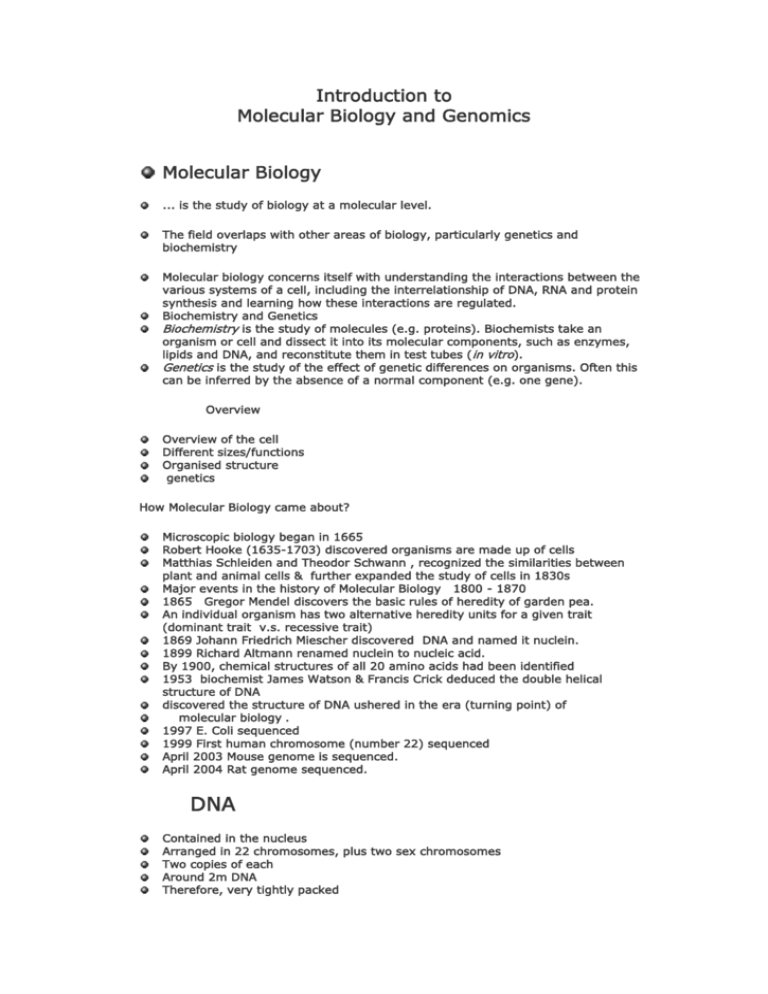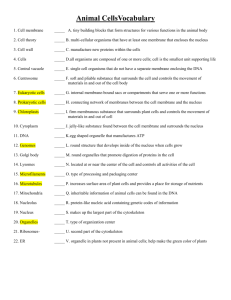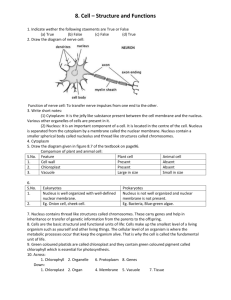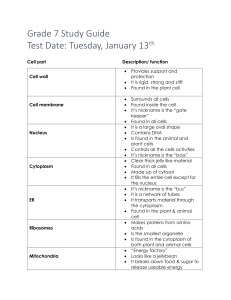Cell biology
advertisement

Introduction to Molecular Biology and Genomics Molecular Biology ... is the study of biology at a molecular level. The field overlaps with other areas of biology, particularly genetics and biochemistry Molecular biology concerns itself with understanding the interactions between the various systems of a cell, including the interrelationship of DNA, RNA and protein synthesis and learning how these interactions are regulated. Biochemistry and Genetics Biochemistry is the study of molecules (e.g. proteins). Biochemists take an organism or cell and dissect it into its molecular components, such as enzymes, lipids and DNA, and reconstitute them in test tubes (in vitro). Genetics is the study of the effect of genetic differences on organisms. Often this can be inferred by the absence of a normal component (e.g. one gene). Overview Overview of the cell Different sizes/functions Organised structure genetics How Molecular Biology came about? Microscopic biology began in 1665 Robert Hooke (1635-1703) discovered organisms are made up of cells Matthias Schleiden and Theodor Schwann , recognized the similarities between plant and animal cells & further expanded the study of cells in 1830s Major events in the history of Molecular Biology 1800 - 1870 1865 Gregor Mendel discovers the basic rules of heredity of garden pea. An individual organism has two alternative heredity units for a given trait (dominant trait v.s. recessive trait) 1869 Johann Friedrich Miescher discovered DNA and named it nuclein. 1899 Richard Altmann renamed nuclein to nucleic acid. By 1900, chemical structures of all 20 amino acids had been identified 1953 biochemist James Watson & Francis Crick deduced the double helical structure of DNA discovered the structure of DNA ushered in the era (turning point) of molecular biology . 1997 E. Coli sequenced 1999 First human chromosome (number 22) sequenced April 2003 Mouse genome is sequenced. April 2004 Rat genome sequenced. DNA Contained in the nucleus Arranged in 22 chromosomes, plus two sex chromosomes Two copies of each Around 2m DNA Therefore, very tightly packed DNA function Carries the blueprint for life Duplication for new cells Make proteins for biological functions: What is Life made of? What is a cell structural and functional units of all living organisms A cell is the smallest unit that is capable of performing life functions unicellular and multicellular organisms bacteria vs. human Characteristics of Cells and Life All living things (single and multicellular) are made of cells that share some common characteristics: basic shape – spherical, cubical, cylindrical internal content – cytoplasm, surrounded by a membrane DNA chromosome(s), ribosomes, metabolic capabilities Two basic cell types: eucaryotic and procaryotic Characteristics of Life Growth and development Reproduction and heredity – genome composed of DNA packed in chromosomes; produce offspring sexually or asexually Metabolism – chemical and physical life processes Movement and/or irritability – respond to internal/external stimuli; self-propulsion of many organisms Cell support, protection, and storage mechanisms – cell walls, vacuoles, granules Transport of nutrients and waste Characteristics of Cells Eucaryotic cells Procaryotic cells Cell biology is a scientific discipline that studies cells – their physiological properties, their structure, the organelles they contain, interactions with their environment, their life cycle, division and death. This is done both on a microscopic and molecular level. Cell (in biology), is the basic unit of life. Cells are the smallest structures capable of basic life processes, such as taking in nutrients, expelling waste, and reproducing. All organisms, such as bacteria and protozoa, are unicellular or single-celled organism, meaning they consist of a single cell. Plants, animals, and fungi are multicellular, that is, they are composed of a great many cells working in concert. Eukaryotic cells are typically about ten times larger than prokaryotic cells. In animal cells, the plasma membrane forms the cell’s outer boundary. With a design similar to the plasma membrane, a cell wall, of prokaryotic cells, it separates the cell from its surroundings and regulates the traffic across the membrane. The eukaryotic cell cytoplasm is similar to that of the prokaryote cell except for one major difference: Eukaryotic cells house a nucleus and numerous other membrane-enclosed organelles. Like separate rooms of a house, these organelles enable specialized functions to be carried out efficiently. The building of proteins and lipids, for example, takes place in separate organelles where specialized enzymes geared for each job are located. Schematic of typical animal cell, showing subcellular components. Organelles: (1) nucleolus (2) nucleus (3) ribosome (4) vesicle (5) rough endoplasmic reticulum (ER) (6) Golgi apparatus (7) Cytoskeleton (8) smooth ER (9) mitochondria (10) vacuole (11) cytoplasm (12) lysosome (13) centrioles . The nucleus was the first organelle to be discovered. The probably oldest preserved drawing dates back to the early microscopist Antonie van Leeuwenhoek (1632 – 1723). He observed a "Lumen", the nucleus, in the red blood cells of salmon . It is the largest cellular organelle in animals. In mammalian cells, the average diameter of the nucleus is approximately 6 micrometers (μm), which occupies about 10% of the total cell volume.The viscous liquid within it is called nucleoplasm, and is similar in composition to the cytosol found outside the nucleus.It appears as a dense, roughly spherical organelle. In cell biology, the nucleus referred to as the "control center", is a membraneenclosed organelle found in eukaryotic cells .The cell nucleus contains the majority of the cell's genetic material, in the form of multiple linear DNA molecules organized into structures called chromosomes. The main function of the cell nucleus is to control gene expression and mediate the replication of DNA during the cell cycle, therefore it is the control center of the cell. Nuclear envelope and pores The main structures making up the nucleus are the nuclear envelope, The nuclear envelope otherwise known as nuclear membrane consists of two cellular membranes, an inner and an outer membrane, arranged parallel to one another and separated by 10 to 50 nanometers (nm).It encloses the entire organelle and separates its contents from the cellular cytoplasm , serving as a barrier to prevent macromolecules from diffusing freely between the nucleoplasm and the cytoplasm. The outer nuclear membrane is continuous with the membrane of the rough endoplasmic reticulum (RER), and is similarly studded with ribosomes. The space between the membranes is called the perinuclear space and is continuous with the RER lumen. The eukaryotic cell nucleus. Visible in this diagram are the ribosome-studded double membranes of the nuclear envelope, the DNA (complexed as chromatin), and the nucleolus. Within the cell nucleus is a viscous liquid called nucleoplasm, similar to the cytoplasm found outside the nucleus. A cross section of a nuclear pore on the surface of the nuclear envelope (1). Other diagram labels show (2) the outer ring, (3) spokes, (4) basket, and (5) filaments. Nuclear pores, which provide aqueous channels through the envelope, are composed of multiple proteins, collectively referred to as nucleoporins.The pores are 100 nm in total diameter; however, the gap through which molecules freely diffuse is only about 9 nm wide, due to the presence of regulatory systems within the center of the pore. This size allows the free passage of small water-soluble molecules while preventing larger molecules, such as nucleic acids and larger proteins, from inappropriately entering or exiting the nucleus. The movement of larger molecules such as proteins is carefully controlled, and requires active transport regulated by carrier proteins. Nuclear transport is crucial to cell function, as movement through the pores is required for both gene expression and chromosomal maintenance. The nucleus of a typical mammalian cell will have about 3000 to 4000 pores throughout its envelope, each of which contains a donut-shaped, eightfoldsymmetric ring-shaped structure at a position where the inner and outer membranes fuse. Attached to the ring is a structure called the nuclear basket that extends into the nucleoplasm, and a series of filamentous extensions that reach into the cytoplasm. Both structures serve to mediate binding to nuclear transport proteins. Nuclear transport









